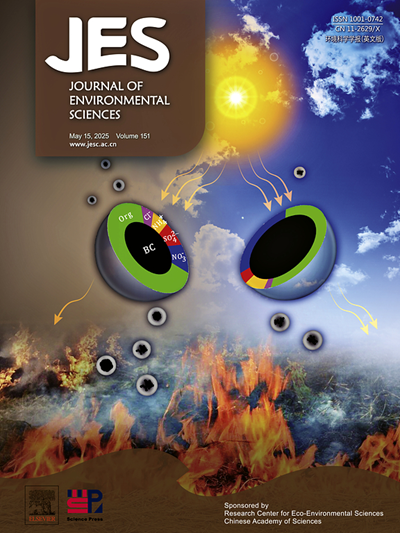二氧化碳浓度升高与营养物对蓝藻生产2-甲基异龙脑的交互作用机制
IF 5.9
2区 环境科学与生态学
Q1 ENVIRONMENTAL SCIENCES
引用次数: 0
摘要
气候变化和富营养化加剧了蓝藻的繁殖,通过产生包括2-甲基异龙脑(MIB)在内的味道和气味(T&;O)化合物,日益损害水质。蓝藻通过将碳代谢中间体重定向到甲基赤藓糖醇磷酸途径来合成MIB。这一过程似乎受到大气CO2分压(pCO2)上升的影响。本研究探讨了在不同的营养条件下,pCO2升高如何影响聚球菌(Synechococcus sp. FACHB-1061)产生MIB。结果表明,二氧化碳分压升高通过降低生物可利用无机碳的限制,提高了蓝藻生物量和总MIB产量,特别是在营养丰富的环境中。相反,在营养受限的条件下,随着二氧化碳分压的增加,总MIB浓度和每细胞产量都显著增加。升高的二氧化碳分压改变了硝酸盐还原酶和碳酸酐酶的活性,减少了受损的氮同化,增强了碳固定。胞外高分子物质的增加和组成的变化表明,在营养不足的情况下,碳溢出和细胞质量下降。此外,氧化应激的标志物,如超氧化物歧化酶活性增加和丙二醛水平升高,表明氧化应激可能刺激次生代谢物的产生。代谢组学分析显示,在营养受限状态下,卡尔文循环和糖酵解的关键中间体,如甘油醛-3-磷酸和乙酰辅酶a,随着pCO2的升高而上调,导致MIB的关键前体增加。这些结果强调了营养物和pCO2升高在调节蓝藻MIB生物合成中的复杂相互作用。研究结果表明,在未来的气候情景下,可能需要重新评估用于减轻蓝藻华和相关T&;O问题的传统营养控制策略。本文章由计算机程序翻译,如有差异,请以英文原文为准。
Interactive mechanism of elevated pCO2 and nutrient on 2-methylisoborneol production in cyanobacteria
Cyanobacterial blooms, exacerbated by climate change and eutrophication, increasingly compromise water quality by producing taste and odor (T&O) compounds including 2-methylisoborneol (MIB). Cyanobacteria synthesize MIB by redirecting carbon metabolism intermediates into the methylerythritol phosphate pathway. This process appears to be influenced by rising atmospheric CO2 partial pressure (pCO2). This study examines how elevated pCO2 affects MIB production in Synechococcus sp. FACHB-1061 under varying nutrient conditions. The results indicate that elevated pCO2 boosts cyanobacterial biomass and total MIB yield, particularly in nutrient-rich environments, by reducing limitations in bioavailable inorganic carbon. In contrast, in nutrient-limited conditions, both total MIB concentration and per-cell production significantly increased with higher pCO2. Elevated pCO2 altered the activities of nitrate reductase and carbonic anhydrase, reducing impaired nitrogen assimilation and enhanced carbon fixation. The increase and compositional changes in extracellular polymeric substances suggested carbon overflow and a decline in cellular quality under insufficient nutrients. Additionally, markers of oxidative stress, such as increased superoxide dismutase activity and higher malondialdehyde levels, suggested that oxidative stress might stimulate secondary metabolite production. Metabolomic analysis revealed that critical intermediates of the Calvin cycle and glycolysis, such as glyceraldehyde-3-phosphate and acetyl-CoA, were upregulated with elevated pCO2 in nutrient-limited status, leading to increase of key precursors for MIB. These results highlight the complex interplay between nutrient and rising pCO2 in regulating cyanobacterial MIB biosynthesis. The findings suggest that conventional nutrient control strategies for mitigating cyanobacterial blooms and associated T&O issues may need reassessment under future climate scenarios.
求助全文
通过发布文献求助,成功后即可免费获取论文全文。
去求助
来源期刊

Journal of Environmental Sciences-china
环境科学-环境科学
CiteScore
13.70
自引率
0.00%
发文量
6354
审稿时长
2.6 months
期刊介绍:
The Journal of Environmental Sciences is an international journal started in 1989. The journal is devoted to publish original, peer-reviewed research papers on main aspects of environmental sciences, such as environmental chemistry, environmental biology, ecology, geosciences and environmental physics. Appropriate subjects include basic and applied research on atmospheric, terrestrial and aquatic environments, pollution control and abatement technology, conservation of natural resources, environmental health and toxicology. Announcements of international environmental science meetings and other recent information are also included.
 求助内容:
求助内容: 应助结果提醒方式:
应助结果提醒方式:


